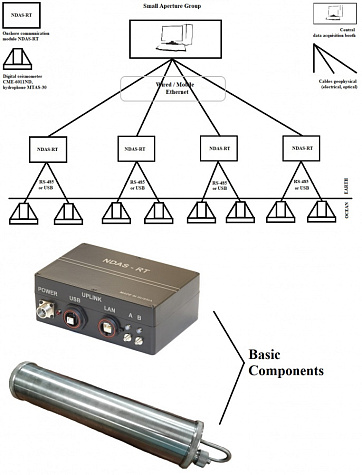Ocean-bottom small aperture group OBAG-8224-RT
A small aperture seismic group consists of three-component seismic receivers which are located at a distance comparable to the wavelength of the studied signal. Such systems are successfully used in seismology to locate weak signals from remote sources.
R-sensors’ engineers have developed products providing the construction of ocean-bottom small aperture groups with high technical characteristics.
The typical structure is given at the figure.
An ocean-bottom station is the base of the group. The station consists of the CME-6011ND digital broadband seismometer and the MTAS-30 broadband hydrophone. Each station is connected to an onshore communication module through a cable.
The cable provides power supply, data transfer and synchronization of the station’s internal clocks with GNSS. RS-485 is an interface of the data exchange which ensures data transfer to a distance of up to 1,200 m. Optionally, fibre-optic lines to transfer data farther than 1,200 m can be used. The SeedLink standard protocol is used to further data transfer.
The onshore communication module consists of the NDAS-RT digital module and a power source. Extra network equipment can be set up depending on the network configuration.
Characteristics Delivery and warranty
| Availability | to order |
| Frequency range | 0.033 Hz (30 sec) - 50 Hz |
| Sensitivity | 2000 V/(m/sec) |
| Clip level | ±7.5 mm/sec |
| Self noise at 1 Hz | 2.5 nm/sec |
| Dynamic range | 127 dB |
| Supply voltage | 5 - 12 V Nominal (4 - 17 V permissible) |
| Power consumption | 300 mW |
| Temperature range | -40...+55°C |
| ADC sampling rate | 1, 10, 50, 100, 125, 250, 500, 1000 Hz |
| ADC resolution | 24 bit |
| Hydrophone sensitivity | 1000 µV/Pa |
| Hydrophone frequency range | 0.033 Hz - 50 Hz |
| Hydrophone self-noise in the bandwidth | 0.01 Pa |
